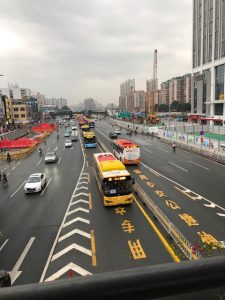[Photo by B. Magavern: Bus Rapid Transit in Guangzhou]
By Bill Magavern
I recently had the opportunity to learn first-hand about China’s efforts to reduce transportation emissions. California can learn from several aspects of China’s experience, and in other areas China could benefit from following California’s example. Thanks to my hosts at Innovative Green Development Program, I met with and spoke with transportation leaders and practitioners in Beijing, Shenzhen and Guangzhou.
PUBLIC TRANSPORTATION
In a rapidly developing country where a city of 6 million is classified as “medium-sized,” providing mobility is quite a challenge, and I did experience traffic jams in all 3 cities. But China has moved aggressively to build impressive public transit systems. The journey of about 1400 miles from Guangzhou to Beijing took only 8 hours via high-speed rail, a smooth ride and a fine alternative to air travel. I found Beijing’s subway system to be extensive, inexpensive, efficient and clean.
The friendly folks at Institute for Transportation & Development Program (ITDP) showed me the successful Bus Rapid Transit (BRT) system they helped plan and implement in Guangzhou, a lively city of over 13 million people (see photo). According to ITDP, “BRT is a high quality, high capacity bus-based mass transit program” that “delivers fast, reliable, and cost-effective mobility through the provision of segregated lanes and enclosed stations [and] rapid and frequent operations.” The Guangzhou BRT has an average daily ridership of more than 850,000 passengers.
TRANSPORTATION ELECTRIFICATION
One can definitely see why Bloomberg Businessweek says “China will almost certainly be the country where the EV revolution arrives fastest.” Shenzhen may be the electric vehicle capital of the world. It certainly is for buses, with all 16,000 of its transit buses running on electric battery power. City policy requires the electrification of both buses and taxis, and delivery trucks are not allowed to enter the city unless they are electric. Conditions for these policies were favorable, I was told, because Shenzhen has an ambitious and well-funded government and a public that demands cleaner air. In addition, the major electric vehicle manufacturer BYD (which also has a major presence in California) is headquartered there.
China also has national rules and subsidies that support rapid electrification. Although the subsidies are now phasing down, a regulatory program that combines elements from the U.S. Corporate Average Fuel Economy program and California’s Zero-Emission Vehicle mandate continues to spur progress.
I heard a concern from some Chinese that there have been fires at charging stations, which leads me to believe that China could learn from the technical standards of the U.S., where this has not been a problem.
Of course, China, like the U.S., should follow California’s lead and phase out the burning of coal as soon as possible in favor of renewable electricity. I was lucky that strong winds had cleared most of Beijing’s air pollution before I arrived, but as the winds died down, the smog returned, and local residents said those conditions were better than normal.
My visit was part of a professional exchange program sponsored by the National Committee on U.S.-China Relations and the China Global Philanthropy Institute, with funding from the State Department.









Very interesting piece. It is quite remarkable that Shenzhen has 16,000 electric transit buses.